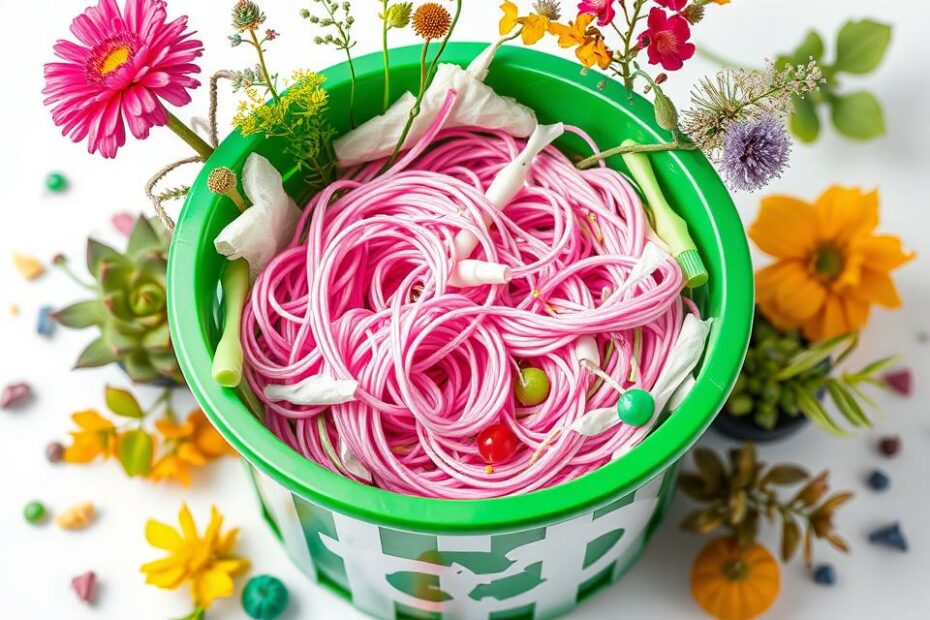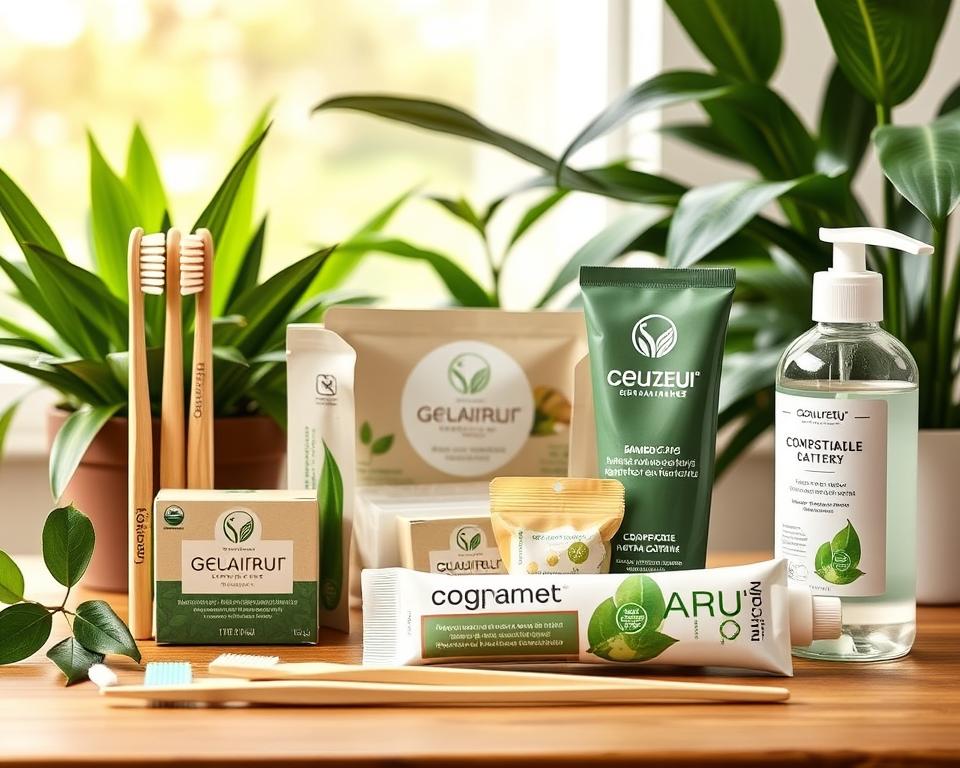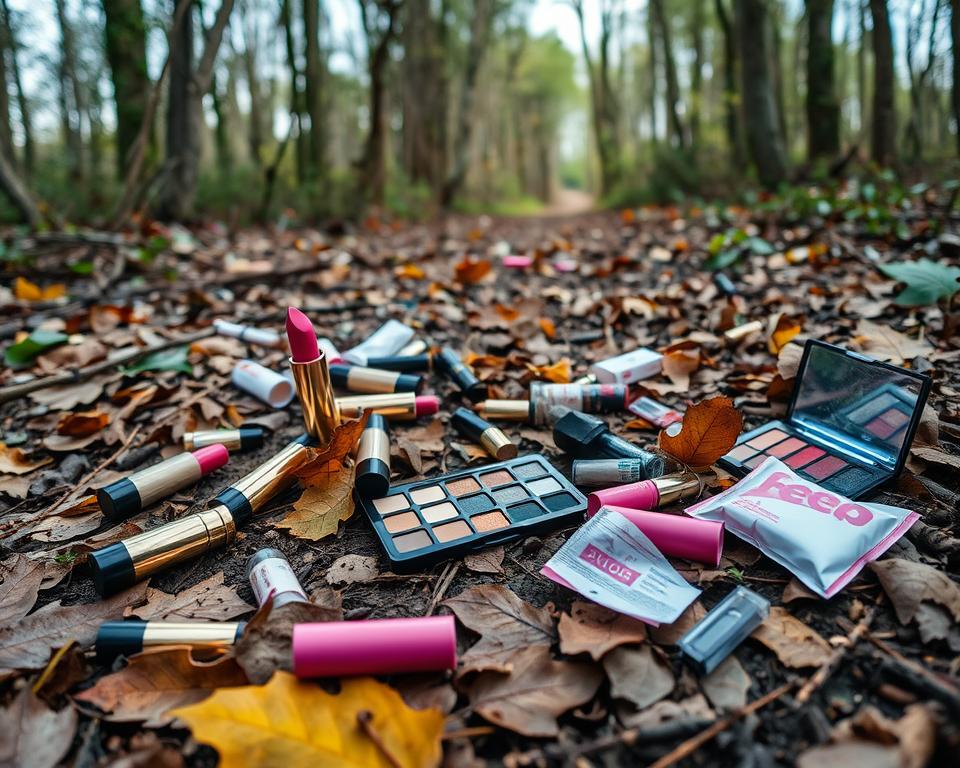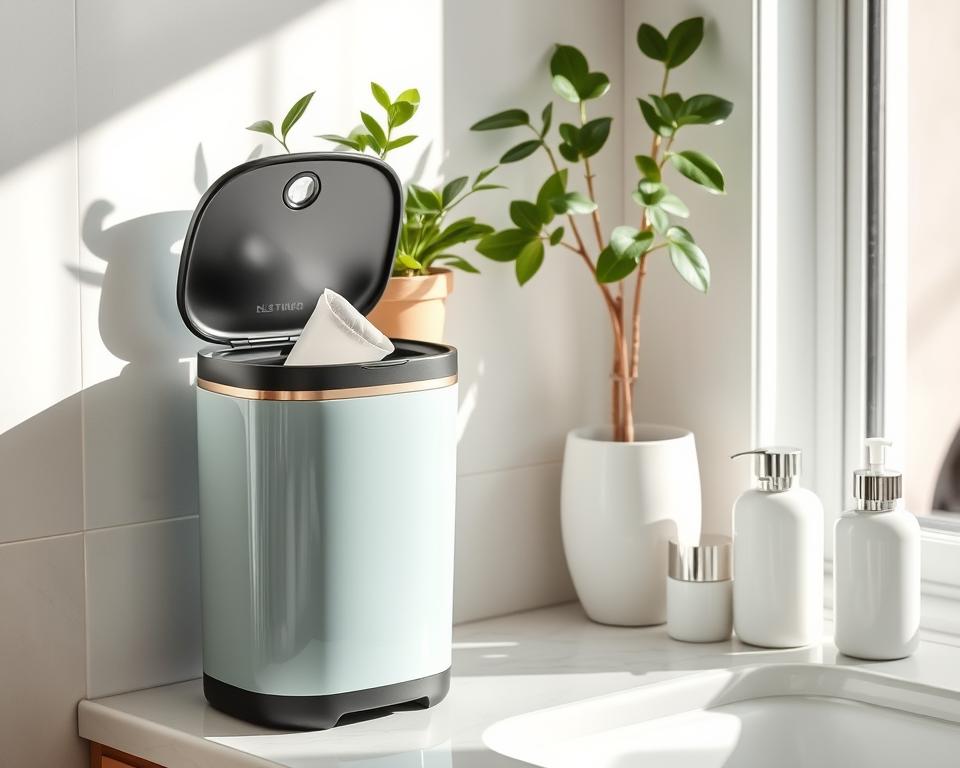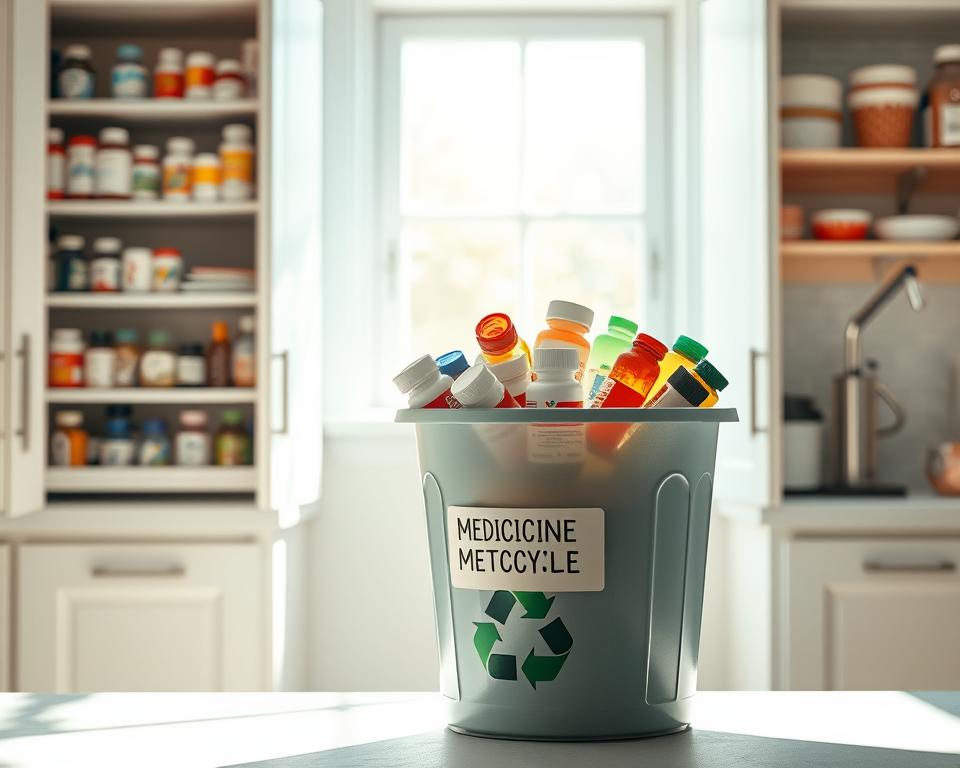Did you know the American Dental Association suggests using floss picks every day? But, traditional disposable floss picks are made from plastic and nylon. They often end up in landfills and waterways, harming our environment. It’s important to know how to dispose of dental floss properly and find eco-friendly alternatives.
Key Takeaways
- Traditional dental floss is usually made from nylon or Teflon. If not thrown away right, it can hurt our ecosystems.
- There are eco-friendly floss options like bamboo or natural silk. They are better for our planet.
- By separating floss from other trash and recycling, we can lessen its harm to the environment.
- Using reusable containers and teaching others about dental floss waste can make our dental care greener.
- Choosing products like biodegradable floss and floss picks is key to eco-friendly dental care.
What Is Dental Floss and Why Proper Disposal Matters
Dental floss is a thin, flexible thread used to clean between teeth. It helps remove food and plaque. But, throwing away used floss the wrong way can harm the environment.
Most dental floss is made from nylon or Teflon. These materials take a long time to break down. They can harm wildlife and ecosystems.
In the U.S., people use a lot of dental floss containers each year. They could fill a football field six stories high. Most of this floss is plastic, adding to global waste.
The plastic industry, including dental floss, has a big carbon footprint. Small plastics like dental floss can harm marine life when they end up in the ocean.
| Statistic | Value |
|---|---|
| Dental floss containers discarded yearly in the U.S. | 700 million |
| Dental floss picks thrown away annually in North America | 4.7 billion |
| Dental floss that could reach the moon and back more than six times | 3.2 million miles |
Flushing non-biodegradable items like dental floss can damage water treatment facilities. The Environmental Protection Agency (EPA) warns about this. Dental floss can cause big clogs, known as “fatbergs,” which are hard to remove.
Throwing away dental floss in the trash helps prevent clogs and damage. It saves money for homeowners and cities. By understanding the impact of dental floss waste, we can make better choices to protect our planet.
Understanding the Environmental Impact of Dental Floss Waste
Using traditional dental floss can harm the environment. Most flosses are made from nylon or Teflon, which don’t break down for centuries. If not thrown away right, they can pollute landfills and waterways, harming animals and plants.
Non-Biodegradable Materials in Conventional Floss
Traditional dental floss is a big problem because it’s not biodegradable. These plastics don’t break down quickly, leading to microplastic pollution. Over time, these small pieces can get into the food chain and even affect human health.
Consequences of Improper Disposal
Throwing away dental floss the wrong way can cause a lot of harm. It can end up in landfills for centuries or in waterways, hurting wildlife and ecosystems. This shows we need better ways to deal with dental floss waste.
To lessen the harm of dental floss waste, we need to find green alternatives. Using eco-friendly dental care and disposing of floss correctly can help a lot. This way, we can all play a part in protecting our planet.
Identifying Eco-Friendly Dental Floss Options
More people now want to help the planet with their choices. This includes looking for eco-friendly dental floss, biodegradable floss, compostable floss, and recyclable floss packaging. These options help cut down on waste from daily flossing.
Biodegradable and Compostable Flosses
Silk floss from Radius is a favorite, with 30 meters for $5.12 US. Vömel plastic-free silk floss with beeswax comes with 10 meters and a vial for $4.46 US. Dental Lace plastic-free silk floss with vegan candellila wax is 66 yards for $7 + taxes, with refills at $5.70 + taxes. Ecodent vegan floss without plastic is 100 yards for $5.49 US.
These biodegradable and compostable flosses are better for the planet. They’re made from plants like silk and bamboo, unlike nylon.
Recyclable Floss Packaging
It’s not just the floss that matters, but the packaging too. Brands like Dental Lace and Ecodent use recyclable floss packaging made from glass and aluminum. These refillable dispensers cut down on single-use plastic and promote sustainable oral care.
By picking eco-friendly dental floss and recyclable floss packaging, we can help the environment. And we can still keep our teeth clean.
Disposing of Dental Floss
Separating Floss from Other Waste
It’s important to throw away used dental floss separately from other trash. Don’t flush it down the toilet because it can block pipes and mess up sewage systems. Wrap it in a small piece of paper or put it in a container before throwing it away.
This action keeps the floss from becoming litter or harming animals. Since traditional dental floss lasts up to 50 years in the environment, it’s key to dispose of it correctly. This way, you help keep our water and oceans clean.
The dental industry encourages us to dispose of floss properly. This helps protect our waterways and oceans from the damage caused by floss that’s not thrown away right. By changing how we dispose of dental floss, we can make a big difference for our planet.
| Floss Type | Material | Eco-Friendliness |
|---|---|---|
| Multifilament Floss | Nylon strands | Least eco-friendly |
| Monofilament Floss | Polytetrafluoroethylene (PTFE) | More eco-friendly than multifilament |
| Bamboo Floss | Natural bamboo fiber | Most eco-friendly |
Choosing biodegradable dental floss and separating floss from waste helps our planet. It makes our oral care routine better for the environment. Together, we can make our world a cleaner, healthier place.
Local Recycling Programs for Dental Floss Waste
It’s important to dispose of dental floss responsibly to protect our environment. Some places now have recycling programs for dental floss. These programs can take in used floss containers, floss picks, and even the floss itself.
To see if these programs are in your area, check with your local waste management or search online. Joining these recycling efforts helps make dental floss disposal more eco-friendly.
| Recycling Program | Accepted Items | Location |
|---|---|---|
| TerraCycle Dental Recycling Program | Toothbrushes, toothpaste tubes, dental floss containers | Available nationwide |
| Colgate Oral Care Recycling Program | Toothbrushes, toothpaste tubes, dental floss containers | Available nationwide |
| Crest Toothpaste Recycling Program | Toothpaste tubes | Available nationwide |
| ARM & HAMMER Toothpaste Recycling Program | Toothpaste tubes and packaging | Available nationwide |
| Oral-B Electric Toothbrush Recycling Program | Electric toothbrushes and accessories | Available nationwide |
By looking into and joining these recycling programs, we can help reduce the harm dental floss causes. Every effort we make towards better waste management counts a lot.
Disposing of Floss Picks and Containers
Dental floss is key for good oral hygiene. But, what about the floss picks and their containers? They need special care to be disposed of right.
Floss picks are often ignored in waste management. Their plastic or wooden handles can litter and harm the environment. Floss picks disposal is vital for waste management.
The containers for dental floss also need proper disposal. Made of plastic or other non-biodegradable materials, they can pollute. Floss containers disposal is as important as floss picks disposal.
Some places might recycle these items. Check your local recycling programs for the best disposal method. If not recyclable, throw them away to avoid litter and environmental harm.
Being mindful of how we dispose of dental floss picks and containers helps a lot. It’s a small step towards a sustainable lifestyle.
Reusing Dental Floss Containers for Other Purposes
Many people are now focusing on sustainability at home. One easy way to cut down on waste is by using old items again. Empty dental floss containers are a great example. They can be reused and help lessen the environmental harm from dental floss.
These containers are perfect for keeping small things tidy. You can store paper clips, beads, sewing tools, or even Lego pieces in them. By doing this, you’re not only cleaning up but also helping the planet.
Before you start using these containers for crafts, make sure to take out the sharp blade. After that, you can clean and decorate them. They’ll become unique storage solutions that make your space special.
Teaching others to reusing dental floss containers and upcycling is a great way to help reduce waste. Share your creative ideas for using these containers. This can inspire others to live more sustainably.
| Statistic | Data |
|---|---|
| Environmental Impact | Recycling and reusing everyday items like dental floss containers promote environmental sustainability. |
| Craft Ideas | The article outlines various craft ideas for reusing dental floss containers, appealing to families and individuals interested in DIY projects. |
| Safety Concerns | Emphasis on removing the blade from the packaging before repurposing the floss containers to ensure safety during crafting activities. |
| Usage | Dental floss containers can be repurposed for multiple uses like sewing kits, bead storage, and snack storage, demonstrating versatility in their application beyond oral hygiene. |
| Portability | Highlighted the portability of repurposed dental floss containers for storing sewing supplies, beads, and small snacks, making them convenient for various purposes. |
| Creativity | Encouragement to get creative by decorating old floss containers for imaginative play and crafting, stimulating creativity in children. |
| Engagement | Invitation for readers to share their own upcycle craft ideas, fostering engagement and potentially generating additional creative reuse concepts within the community. |
By reusing dental floss containers, you help the upcycling movement and cut down on waste at home. Get creative with your containers and encourage others to find new uses for everyday items.
Educating Others on Proper Disposal of Dental Floss
Spreading Awareness in Your Community
It’s important to teach others about the right way to throw away dental floss. This helps lessen its harm to the environment. We can all help by teaching our community about caring for our teeth in a green way.
Talk to your family, friends, and neighbors about dental floss disposal. Explain how bad it is for the planet and how good eco-friendly options are. Tell them to use biodegradable or compostable floss and to throw it away right.
Also, reach out to dentists, schools, and community centers. Offer to share knowledge or give talks. These places can help spread the word about taking care of our teeth in a way that’s good for the planet.
Work with others to plan big events or campaigns. These can teach people about dental floss and how to care for their teeth better. Together, we can make a big difference and get more people to make smart choices.
By sharing what we know and pushing for the right way to dispose of dental floss, we help our community become greener. This leads to less waste from something we all use every day.
Choosing Sustainable Dental Care Products
More people are thinking about how their actions affect the planet. This includes what they use for dental care. Now, there are many eco-friendly options for toothbrushes, toothpaste, and more.
Old plastic toothbrushes take a long time to break down, harming our environment. Using biodegradable toothbrushes made from bamboo is a better choice. Eco-friendly dental floss, like silk or biodegradable types, also helps keep our planet clean.
Toothpaste brands are now offering greener options in recyclable packaging. Using less water while brushing is another way to save resources. Choosing digital X-rays and bringing reusable cups to the dentist also helps the environment.
By choosing sustainable dental care, we can all help reduce waste and support the planet for the future.
Sustainable Dental Care Options
- Biodegradable toothbrushes made from bamboo or other eco-friendly materials
- Dental floss made from silk or compostable materials with recyclable packaging
- Toothpaste in recyclable packaging that uses natural ingredients
- Turning off the tap while brushing to conserve water
- Using digital X-rays to reduce radiation exposure and eliminate chemical developers
- Bringing reusable cups to dental offices to minimize single-use plastics
- Participating in dental product recycling programs
- Exploring DIY oral care remedies with natural ingredients
| Conventional Dental Products | Sustainable Dental Alternatives |
|---|---|
| Plastic toothbrushes | Bamboo or biodegradable toothbrushes |
| Non-biodegradable dental floss | Silk or compostable dental floss |
| Toothpaste in non-recyclable tubes | Toothpaste in recyclable packaging |
| Single-use plastic cups at dental offices | Reusable cups brought by patients |
Choosing eco-friendly dental products helps us care for our planet and our teeth. There are many options, from biodegradable toothbrushes to green floss and toothpaste. These choices help us reduce waste and support a healthier planet.
Reducing Dental Floss Waste
Dental floss is key to our oral health, but it affects the environment too. The U.S. uses about 3 million miles of traditional dental floss each year. This creates a lot of waste, enough to cover a football field six stories high if everyone flossed daily.
Most dental floss is made of nylon, a synthetic material that can’t be recycled. The wax on nylon floss also contains harmful chemicals called PFCs. These materials add to landfill waste and harm the environment.
To lessen dental floss’s environmental impact, we can choose sustainable dental hygiene options. Dental Lace is a biodegradable, compostable floss made from mulberry silk and candelilla wax. It comes in reusable containers, helping to reduce dental floss waste.
Switching to eco-friendly dental floss and managing waste better can help. It’s a small step towards a greener dental routine. Every choice we make can make a difference for the planet.
Disposing of dental floss
It’s important to dispose of used dental floss correctly to protect our environment. Traditional dental floss is made of nylon and can’t be recycled. It’s harmful to our ecosystems.
Don’t flush used floss down the toilet. It can clog pipes and harm sewage systems. Instead, wrap it in paper or put it in a container before throwing it away.
This simple action stops floss from becoming litter or harming wildlife. Some places have special recycling for dental floss and oral care items. Being careful with how we throw away dental floss helps keep our environment clean and healthy.
Eco-Friendly Floss Disposal Options
- Wrap used floss in a small piece of paper before placing it in the trash.
- Dispose of floss in a secure container to prevent it from becoming litter.
- Check if your local community offers a recycling program for dental floss and other oral care products.
When it comes to disposing of dental floss, the key is to avoid flushing it down the toilet. Instead, choose methods that reduce its environmental impact and support waste management. Making smart choices helps our planet for the future.
Conclusion
Properly disposing of dental floss is key to reducing its environmental impact. Choosing eco-friendly floss, like biodegradable options, helps a lot. These are made from materials like bamboo or corn.
Also, separating floss from other trash and using local recycling programs helps. These actions lead to a better future for dental care and more.
Telling others about the need for sustainable dental care is important too. By sharing what we know, we can help our communities. This is crucial as dental floss use keeps growing.
By taking small steps, like disposing of floss right, we can make a big difference. Making smart choices and joining waste-reduction efforts helps our planet. Together, we can ensure a healthy, sustainable world for all.
FAQ
What is dental floss and why is proper disposal important?
Dental floss is a thin, flexible thread used to clean between teeth. It’s made from materials like nylon or Teflon. These materials can harm the environment if not disposed of correctly.
What are the environmental consequences of improper dental floss disposal?
Improper disposal of dental floss can harm wildlife and marine life. It can also contribute to microplastic pollution. This pollution affects ecosystems and human health.
What are some eco-friendly dental floss options?
There are dental floss options made from biodegradable materials like silk or bamboo. Some brands also offer recyclable packaging. This reduces waste.
How should used dental floss be disposed of?
Used dental floss should not be flushed down the toilet. It can clog pipes. Wrap it in paper or put it in a container before throwing it away.
Are there any special recycling programs for dental floss and other oral care products?
Yes, some communities have recycling programs for dental floss and other oral care products. Check with your local waste management or search online to see if they have one.
How can I reuse or repurpose empty dental floss containers?
Empty dental floss containers can be reused for many things. Use them to store small items or as desk organizers. This reduces waste and promotes sustainability.
How can I educate others about the importance of proper dental floss disposal?
Share tips and resources with family and friends. You can also talk to dentists’ offices or schools. This helps spread awareness and reduce environmental impact.
What other sustainable choices can I make for my dental care routine?
Choose toothbrushes, toothpaste, and other products that are recycled or biodegradable. This makes your dental care routine more sustainable.
How can I reduce the overall amount of dental floss waste I generate?
Use dental floss sparingly and choose reusable containers. Consider using water flossers or interdental brushes as alternatives. This reduces waste.
Source Links
- https://theroundup.org/are-floss-picks-recyclable/
- https://www.dentalproductsreport.com/view/dental-practice-waste-handling-and-disposal-101
- https://www.terraandco.com/blogs/sustainable-living/why-is-dental-floss-bad-for-the-environment?srsltid=AfmBOor3RlvRNGCi0vkFzpj_3zodyJ-gTSunObfi9n7jq1bVX-TKsAeW
- https://betterbiom.com/blogs/learn/can-you-flush-dental-floss-down-the-toilet?srsltid=AfmBOorNt2Cy2N0LVNtEblNS1yLWHB-2VfMmAZhcy8Va-yl180gSbUiA
